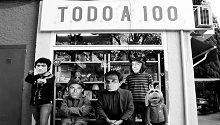Terrorismo de autor
Terrorismo de autor is an anonymous-delirious collective created in 2012. With its social and political audiovisual works it aims to bring about an aesthetic and ideological remake of May 1968. Combining humour, virality, performance and nouvelle vague, it proposes a revolutionary action that is creative rather than either violent or pacific.
Terrorismo de autor: los artistas de todo a 1 euro is an exclusive by Terrorismo de autor for Pantalla CCCB: a Month, an Artist. The piece includes some of its works to date: #Ocupaeldinero, Los cuatrocientos golpes, Le jour et la nuit, Recortes reales, Educación para la ciudadanía, Freudlán, el neoedipo and VHS Haikiu.
“The only option open to us is to let our identity rant and rave alongside History. Excluded from the social game, we make a hallucinatory comeback: we are the Committee of Public Safety, we are El Chavo del 8, we are Pier Paolo Pasolini, we are Buenaventura Durruti, we are Felipe Juan de Todos los Santos de Marichalar y Borbón!! Political psychosis for times of denial. A Chinese man said: ‘Action must not be a reaction, it must be creation.’ This is why we push our images, which are already precarious, to the edge of precariousness. Faced with the urgency of the present moment, we bring together images that place need, desire and adoption of a stance before the siren songs of Spectacle, vanity and entertainment, before the conditions of precariousness and exploitation in which they take place.”
https://es-es.facebook.com/Terrorismodeautor
Terrorismo de Autor could have been one of the groups invited by Influencers, a festival whose co-director, Bani Brusadin, recently defined it as “a container of experiments” by so-called counter-cultural or guerrilla individuals or collectives. This body of critical strategies ranges from politically aware, organized actions to projects that just want to partake in the confusion promoted by the Internet.
The members of TdA have taken advantage of the CCCB’s invitation to produce a pot pourri of some of their earlier works, editing them into a piece suggestive of trolling. Highlighting the precarious (and opaque) nature of the world of work is a good idea. Given the degree of trustworthiness demonstrated by many institutions in recent years, mistrust is the order of the day, and there is a great deal of work to be done to achieve the desirable degree of transparency—as, suspiciously, any corrupt politician might say. However, compared to what I’ve been paid recently, I find the inclusion of their work at Pantalla CCCB is not badly remunerated (though the group seems to have forgotten to divide the euro by the number of members).
The expression “advertising without a client”, which TdA use even for talks about theory, does not strike me as very fortunate. Perhaps that’s due to my particular aversion to advertising. When presented as advertising or propaganda, even the truth becomes a lie. Many makers of expensive advertising and video clips are also unashamed admirers of Nouvelle Vague, though less ironic than TdA. These directors are paid a great deal of money for their work, but we know that where there’s money, there’s violence, and where there’s most money is where most violence is found. Are we prepared to put up with the servitude and stupidity imposed by the sacrosanct business of advertising? Though they work for pleasure and entertainment, the TdA brand name is still a client of the TdA publicists. To some degree, the CCCB, too, is advertising itself by inviting TdA to the plasma screen of the comfortable Xcèntric Archive.
These days there is a lot of talk about the health (or lack of it) of public institutions and media. How do we imagine an open television station, as imagined by the great Jaime Davidovich, that seriously airs thinking, the arts and criticism of the system? The CCCB forms part of this system, though, like other institutions, it has cracks through which conflicting views slip, like contraband. The best institution would perhaps be the one with most cracks, the one that allows most criticism to filter through. Here, I recommend a short video in Spanish by John Holloway entitled “No existe la pureza revolucionaria” [There is no such thing as revolutionary purity], referring to a kind of purity mocked by TdA when they mix Marx, for example, with Froilán de todos los Santos in their masks. We shouldn’t be too scandalized by the transgressive spirit of these humorous videos. Some of the irreverence we see here remind me of elements of the commercial British series Doubletake (Channel 4), by Alison Jackson; of course, Britain is quite a way ahead of us in these things.
The critical humour of TdA also plays with the serious approach to cinema and erudition to which the Nouvelle Vague contributed with its mania for citing—one which they share, always against a backdrop of irony. “We want to be delirious”, they say in the interview. It is strange for someone to say they want to do something that means: “in an acutely disturbed state of mind characterized by restlessness, illusions and incoherence”—mainly because these are things that people do unintentionally. They also claim to follow what they call the Situationist, “child dérive”, which might fit in with the restlessness, illusions and incoherence contained in the definition of delirium. Though the reference to children perhaps refers more to the as yet untainted eyes of children, able to see things that adults no longer can. Rafael S. Ferlosio, in “La contracultura”, writes: “The little boy who dares to say ‘The emperor has no clothes on’ was perhaps—gasp!—paid by the emperor himself.” Perhaps the integration of protest is the most advanced form of censure of today’s democracies. As Holloway says in his video, “This is an antagonistic world, a contradictory situation.”
Félix Pérez-Hita (Video artist and cultural critic)


